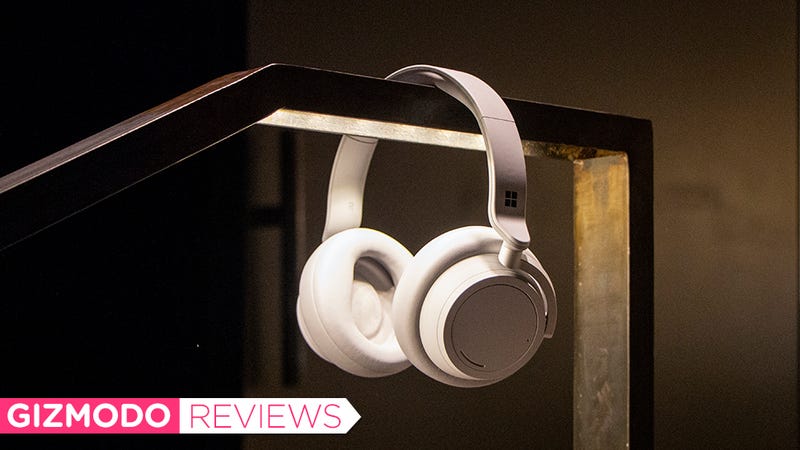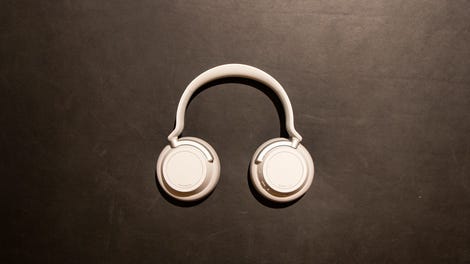
I’ll say one thing about the new Microsoft Surface Headphones. They’re pretty, especially if you like the color grey. I’ll tell you a few other things. The Cortana features are frustrating. The noise-canceling tech is basically fine. The ear cups aren’t super comfortable. And the headphones just don’t sound that amazing. They’re a good fashion statement. “Look at me,” these branded cans scream, “I’m a loyal Microsoft user.”
Nothing wrong with that. The $350 wireless Surface Headphones have that high quality feel that’s featured in the rest of the new wave of Microsoft hardware. In addition to the ghostly grey finish, the headphones are sturdy and sleekly sculpted with the same clean lines you’ve seen on the Surface tablets. The design actually reminds me a lot of the very fancy Beoplay H9i luxury headphones, which cost $500.
HeadphonesBluetooth HeadphonesBluetooth
HeadphonesBluetooth
Microsoft Surface Headphones
HeadphonesBluetooth
Microsoft Surface Headphones
Microsoft Surface Headphones
What are they?
Wireless, noise-cancelling headphones with Cortana
Cost
$350
Like
Nice-looking headphones
No Like
Don't work great, don't sound great
Things start to get a little less perfect when using the Surface Headphones, though. The ear cups seem to have too much padding, leaving little room for your ears. The buttons are hard to feel, making it tough to turn off the headphones or toggle the Cortana mic on and off. There is a feature that lets you twist rings around the outside of the headphones to adjust the volume and the noise-canceling feature, but there’s no feedback about what’s happening. So you might nudge the volume knob without even knowing it because there’s not a click or a ding or a soothing robotic voice that tells you the volume has been adjusted.
This feedback thing bugs me because the Surface Headphones are evidently designed to be a personal assistant that you wear. The headphones connect with the Cortana on your PC or phone, and from there, you can just say things like “Hey Cortana, when will winter end?” or “Hey Cortana, play some yacht rock.” Microsoft’s artificially intelligent virtual assistant will answer your questions and obey your commands. If you don’t like the idea of wearing an always-on microphone, you can mute it, and do a long press on either ear cup to beckon Cortana. When you first turn them on, the headphones also tell you how many hours of battery life are left, which might have been my favorite feature since it’s such useful information with wireless headphones. Feedback on volume adjustments or noise canceling isn’t so essential, but it feels like something that’s missing.
You can also add usability to that list of missing things. I just couldn’t get the Surface Headphones to work right! It’s important to point out here that there are really two ways to use the Surface headphones: as basic Bluetooth headphones or as a personal assistant that’s strapped on your head. The two are sort of mutually exclusive. As basic Bluetooth headphones, they worked perfectly—connected to my devices right away and played music perfectly well. As soon as I introduced Cortana into the mix for the personal assistant stuff, though, things got all messed up. There’s a separate pairing process through the Cortana app that worked for me initially when I connected the headphones to my iPhone, but the headphones shit the bed when I tried to pair them with a Surface tablet. Weird, given the similar names of the devices.
I ought to point out that I did not troubleshoot with Microsoft’s PR team here. (Note: Microsoft has since told Gizmodo that this behavior is not expected and we are working with them to resolve the issue. We will update when we have more clarity.) When I’m in the setups stage of testing a new gadget, I like to experience it just like the average person would, and in this case, I think I got about as angry with the dysfunction as the average person who uses a wide variety of gadgets would. The Microsoft device worked with my Apple phone, but it didn’t work with my Microsoft tablet. Ahhh!!! When Cortana did work, I could connect the virtual assistant to my Spotify account, but when I asked Cortana to play music on Spotify, she told me that Spotify was not yet compatible. AHHHH!!!!! I couldn’t help but wonder if this all would have been different, if I used only Microsoft devices. Maybe connecting the headphones to an iPhone messed them up for good, and I should’ve just stuck to Surface gadgets.
Despite my troubles, at least I could use these damn things like regular noise-canceling headphones. But believe it or not, there are a couple of issues with the Surface Headphones as noise-canceling headphones. They’re not great. Even when it’s cranked all the way up, the noise-canceling isn’t nearly as powerful as the Bose QuietComfort or the Sony 1000X series. I could hear my coworkers chatting while wearing the Surface Headphones, while those others would block out something like that completely.
The sound quality could also be better. The Surface Headphones don’t sound bad. They’re just tuned in a way that I find off-putting for a lot of music genres. It’s as if someone has pulled up the lower end of the midrange notes and squished down the upper end of the trebles, making the equalizer curve look like a swelling wave. This brings out the richness of vocal tracks. It almost sounds like you’re sitting in the studio with Otis Redding on “The Dock of the Bay.” But it takes the brilliance out of, say, the acoustic guitar on “Solsbury Hill” by Peter Gabriel. A lot of headphones let you adjust the equalizer to your own tastes, and that option would have been great for me here. For now, however, the Surface Headphones don’t offer any app control outside of what you can (or can’t) do with Cortana.
The Surface Headphones will probably get better. Microsoft is new to the headphone business, and at the end of the day, the coolest-sounding features on these cans are software driven. An equalizer app could fix the sound quality issues. A firmware update could solve the Cortana woes. Heck, a tiny software update could add a little feedback to that volume knob I want to like. The Surface Headphones could be good.
For now, they’re fine. They’re not $350 fine, because $350 is the price point that puts the Surface Headphones in direct competition with the best noise-canceling headphones on the market. If you’re a Microsoft power user, I can see how you might pay for the brand over the features. Maybe you won’t have as much trouble getting Cortana to work as I did, and the Surface Headphones will work better in an all-Microsoft ecosystem. For everyone else just looking for a great set of noise-canceling headphones, though, look elsewhere.
Update 4:40PM – After a conversation with Microsoft, a couple software updates, and an untold amount of time tinkering, we did get Cortana to work on the headphones. The voice-enabled assistant works much in the same way it would through your phone or Surface tablet. But if you decide to buy these headphones, you will have to install special software to use them with Cortana.
README
- Very pretty
- Sorta comfortable, sorta not
- Sound kinda muddy
- Cortana’s kinda finicky
- Guess I just don’t like them
Share This Story